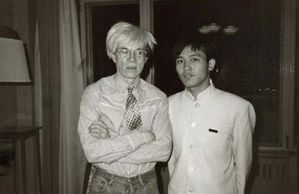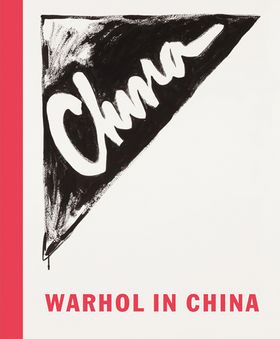| | BOOK FORMAT
Clth, 10.5 x 12.25 in. / 312 pgs / 30 color / 250 duotone. PUBLISHING STATUS
Pub Date 2/28/2014
Out of print DISTRIBUTION
D.A.P. Exclusive
Catalog: FALL 2013 p. 92 PRODUCT DETAILS
ISBN 9783775736626 TRADE
List Price: $70.00 CAD $92.50 AVAILABILITY
Not available | TERRITORY
NA LA | “The critical exploration of commodity fetishism that was at the core of Warhol’s practice comes to the fore of Chinese avant-garde art, as artists examine and critique the (commoditized) values and ideologies in everyday post-revolutionary China.” – Michael Frahm |
| | | Warhol in China
 Andy Warhol (1928-1987) flew to Beijing (via Hong Kong) in 1982, recording his impressions in brief journal entries while also photographing with his typical fanatical diligence. He encountered a capital virtually untainted by advertising and commerce, but nonetheless on the verge of an enormous transition. Following Mao's death in 1976, an art scene was slowly beginning to emerge in China. Under Mao, art had been deployed mainly as a propaganda tool to communicate government propaganda. By the time of Warhol's visit, new artistic strategies had established themselves. The Political Pop movement, Gaudy Art and "The Stars," a group of younger artists to which Ai Weiwei belonged, were all greatly influenced by Warhol and other protagonists of Pop. For this group, Warhol's classic silkscreen print "Mao" (1972) served as a critical point of departure for their artistic reevaluation of the iconography of communism. Warhol's presence in China electrified Beijing's avant-garde, and his photographs record both his own delight in encountering the city's artists (as well as other sights--he was much impressed by the Great Wall) and their delight in him. These photographs consequently possess both artistic and documentary merit. Andy Warhol (1928-1987) flew to Beijing (via Hong Kong) in 1982, recording his impressions in brief journal entries while also photographing with his typical fanatical diligence. He encountered a capital virtually untainted by advertising and commerce, but nonetheless on the verge of an enormous transition. Following Mao's death in 1976, an art scene was slowly beginning to emerge in China. Under Mao, art had been deployed mainly as a propaganda tool to communicate government propaganda. By the time of Warhol's visit, new artistic strategies had established themselves. The Political Pop movement, Gaudy Art and "The Stars," a group of younger artists to which Ai Weiwei belonged, were all greatly influenced by Warhol and other protagonists of Pop. For this group, Warhol's classic silkscreen print "Mao" (1972) served as a critical point of departure for their artistic reevaluation of the iconography of communism. Warhol's presence in China electrified Beijing's avant-garde, and his photographs record both his own delight in encountering the city's artists (as well as other sights--he was much impressed by the Great Wall) and their delight in him. These photographs consequently possess both artistic and documentary merit.
Featured image, captioned "Andy Warhol and Bellboy, 1982", is reproduced from Warhol in China. |
| | | | |
| |
| |

|
FORMAT: Clth, 10.5 x 12.25 in. / 312 pgs / 30 color / 250 duotone.
LIST PRICE: U.S. $70.00
LIST PRICE: CANADA $92.5
ISBN: 9783775736626
PUBLISHER: Hatje Cantz
AVAILABLE: 2/28/2014
DISTRIBUTION: D.A.P.
RETAILER DISC: TRADE
PUBLISHING STATUS: Out of print
AVAILABILITY: Not available
TERRITORY: NA LA | D.A.P. CATALOG: FALL 2013 Page 92 | PRESS INQUIRIES
Tel: (212) 627-1999 ext 217
Fax: (212) 627-9484
Email Press Inquiries: publicity@dapinc.com | TRADE RESALE ORDERS
D.A.P. | DISTRIBUTED ART PUBLISHERS
Tel: (212) 627-1999
Fax: (212) 627-9484
Customer Service: (800) 338-2665
Email Trade Sales: orders@dapinc.com |
| Warhol in China Published by Hatje Cantz. Andy Warhol (1928-1987) flew to Beijing (via Hong Kong) in 1982, recording his impressions in brief journal entries while also photographing with his typical fanatical diligence. He encountered a capital virtually untainted by advertising and commerce, but nonetheless on the verge of an enormous transition. Following Mao's death in 1976, an art scene was slowly beginning to emerge in China. Under Mao, art had been deployed mainly as a propaganda tool to communicate government propaganda. By the time of Warhol's visit, new artistic strategies had established themselves. The Political Pop movement, Gaudy Art and "The Stars," a group of younger artists to which Ai Weiwei belonged, were all greatly influenced by Warhol and other protagonists of Pop. For this group, Warhol's classic silkscreen print "Mao" (1972) served as a critical point of departure for their artistic reevaluation of the iconography of communism. Warhol's presence in China electrified Beijing's avant-garde, and his photographs record both his own delight in encountering the city's artists (as well as other sights--he was much impressed by the Great Wall) and their delight in him. These photographs consequently possess both artistic and documentary merit.
| VIEW MORE ONLINE AT: https://www.artbook.com/9783775736626.html |
| | |
|
